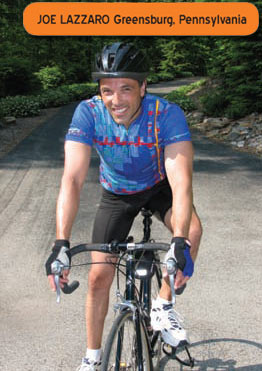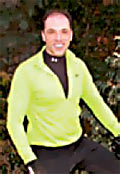Cycling The Road To Health: Joe Lazzaro (Diabetes)
Bicycling is an adventure, a thrill, and a freeing experience that non-cyclists can only imagine. It's more than that, though—cycling is a way to get stronger; to get healthier; to fight back as your body battles illness. Brave cyclists have battled a variety of illnesses, helped along by their dedication (long-term or newly found) to cycling. So as you go out and face illness, or frustrations, or just  a boring day at work, know that cycling awaits, offering you freedom, excitement and health.
a boring day at work, know that cycling awaits, offering you freedom, excitement and health.
Dealing With Diabetes
JOE LAZZARO is a 43-year-old attorney in Greensburg, Pennsylvania. He owns a collection firm near Pittsburgh called The Keystone Group. Married and with two young children, Lazzaro credits cycling, and the strength it gives him, as an ally in his fight against diabetes.
When did you start cycling?
When I was an undergrad in journalism at Penn State in the 1980s, and later attending the University of Pittsburgh School of Law, cycling was my mode of transportation to, from and around the campuses. Now in my early 40s, cycling has become my main sport for the last four to five years. I find it is the best activity to control diabetes.
I now live on the mountainous side of Pennsylvania. The hills from Pittsburgh to the Laurel Highlands make cycling a tougher challenge here, but those kinds of challenges make me stronger. And strength is my key ally in overcoming the challenges of diabetes. An insulin-dependent diabetic since age seven, I believe that regular, hard exercise minimizes the long-term effects of diabetes. Cycling is my primary sport.
The key to living a long, healthy life as a diabetic is maintaining normal blood sugar levels. Cycling helps me do that. A bike workout burns up carbs, keeps muscle strength at its peak and provides regular bursts of endorphins that accompany every good ride. Before some longer rides, I significantly reduce or eliminate my insulin intake, and still end my ride with normal or even low blood sugar levels.
What is a day in your bicycling life like?
As a diabetic cyclist, I must be aware of any drop in blood sugar levels and be prepared to respond when that happens. That means monitoring sugar levels before I start on my ride, and packing (and consuming) plenty of energy drinks and bars for the trip. Riding is not only great for my body. Riding totally relaxes my mind. I do some of my best thinking while I'm on my saddle, traveling past hundreds of acres of farmland on a sunny afternoon or cruising alongside one of Pittsburgh's winding rivers. Stress creates some biochemical changes in all people, and it can be one of the worst contributors to losing control of diabetes. Operating a niche law practice with 60 employees can be a lot of stress. The cycling high helps drive that stress away.
While I enjoy the peace of solitary riding, my best rides are with a friend (or my nine-year-old son). I'm a social person and I prefer riding with my buddies.
Do you recommend cycling to others? Have any taken you up on it?
My younger brother Jim actually led me into the sport of cycling. After cheering him on at several MS-150 rides from Philadelphia to Atlantic City (150-mile fundraiser rides for the the National Multiple Sclerosis Society), I took on the sport. My wife and kids sometimes ride with me on summer afternoons on the beautiful stretches of Ohiopyle, Pennsylvania. along the Youghiogheny River.
What kind of bike are you currently riding?
A sport-road bike.
What's the best part about cycling?
Cycling is a sport almost without limitations. It can take you anywhere you want to travel, give you new perspective on places, stay with you well into the later years of your life and, if you stick with it, will help you become and stay a healthier and stronger person.
What's the worst?
We live in a hurried society. Careless driving and road rage are the biggest threats to cyclists. While many communities are improving their roadway designs to accommodate the sport, the distracted driver on the cell phone or the hothead with intolerance for cyclists still pose a serious risk. Whether I’m riding ten miles or a full century, I always stay alert to my surroundings.
This article was first published in the League of American Bicyclist's American Bicyclist magazine. It is used with their kind permission.
